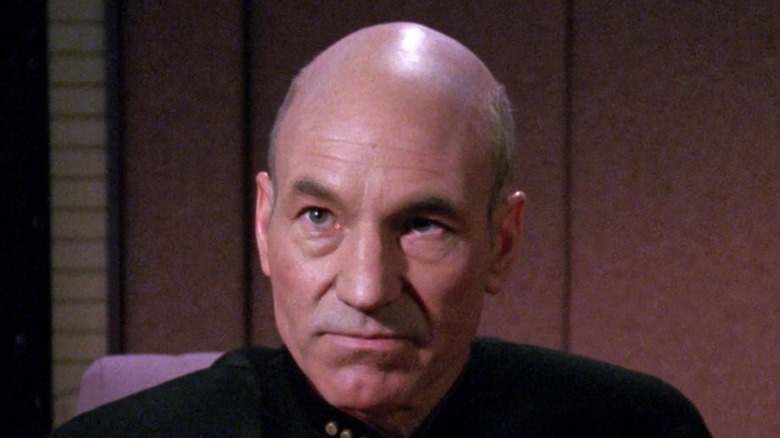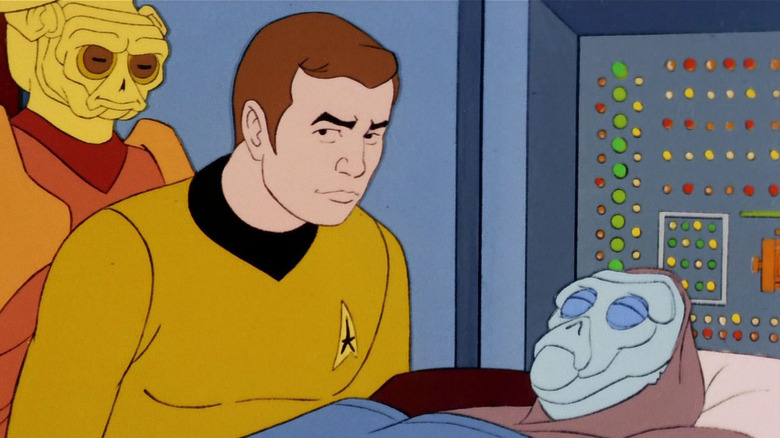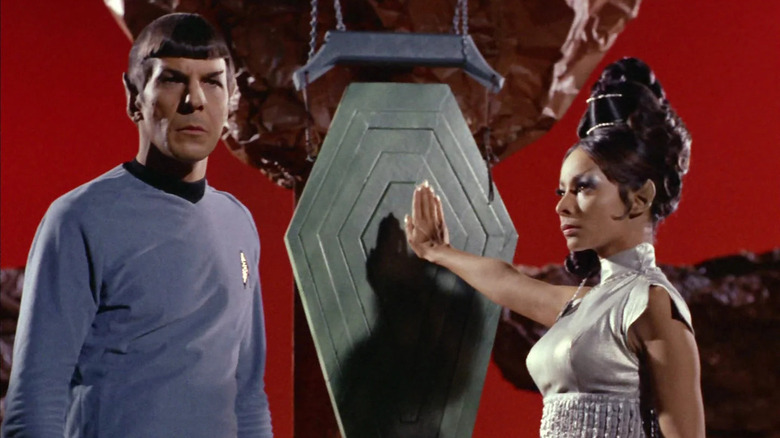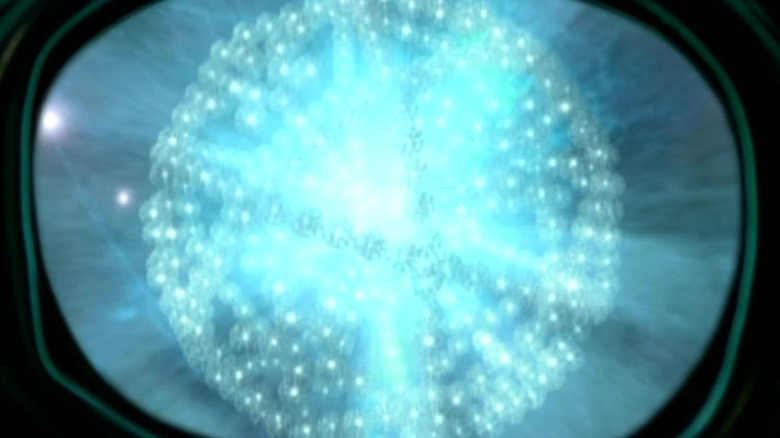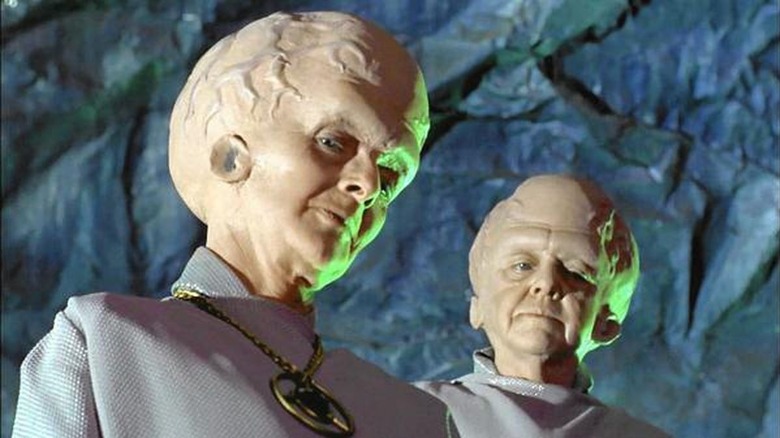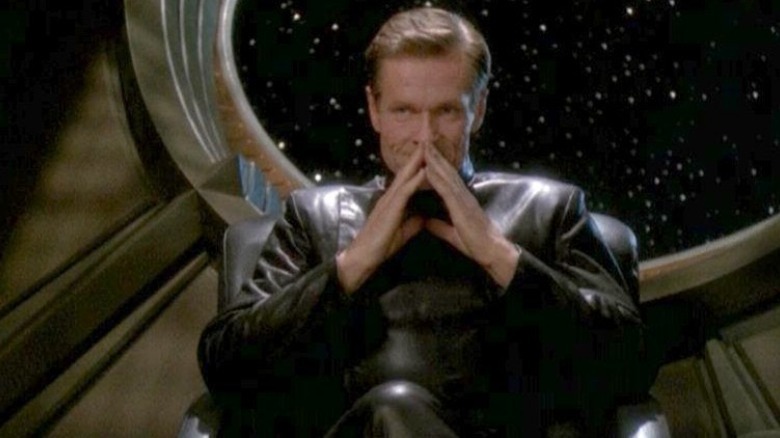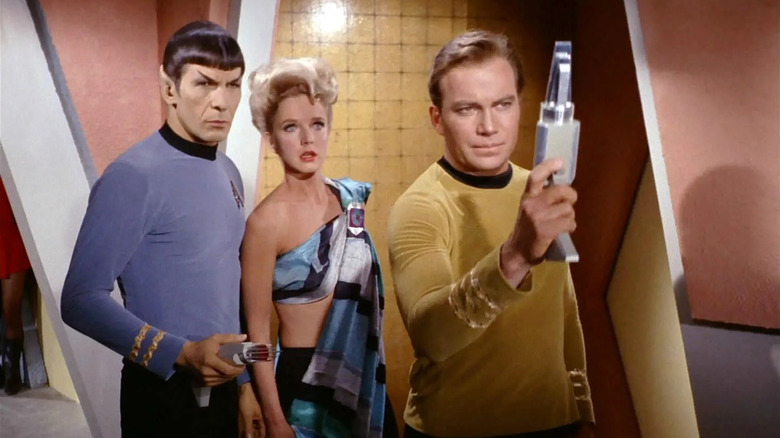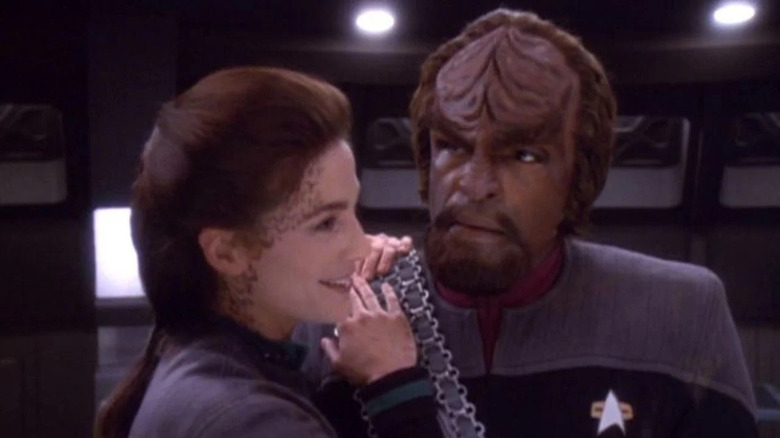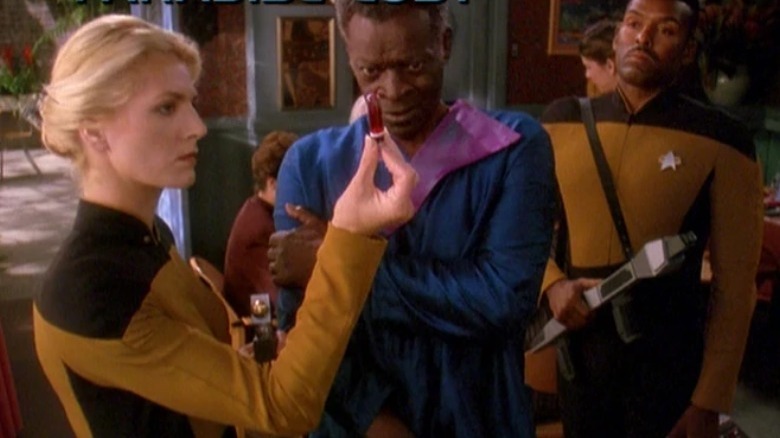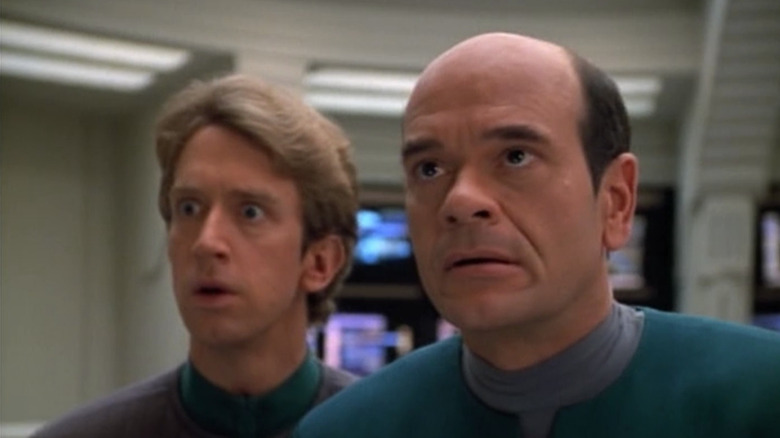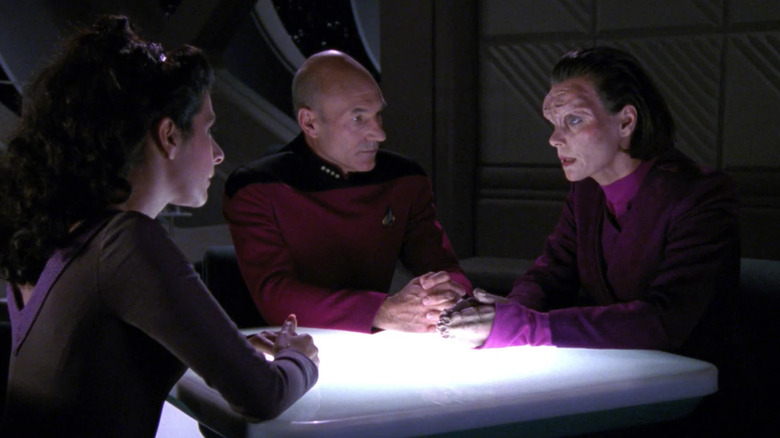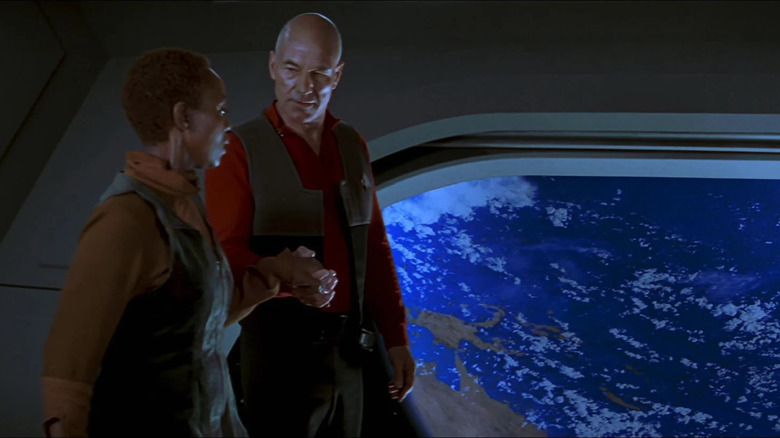Bizarre Laws In The Star Trek Universe Explained
If you were asked to come up with the most rules-obsessed sci-fi film and television franchise ever, chances are pretty good that you would land on "Star Trek." The many series under the "Trek" umbrella are packed full of folks walking around in Starfleet uniforms, quoting regulations, and referencing alien law. Now, at least half the time rules are referenced they're broken within 20 minutes at the most. But those rules are there nonetheless.
Many of the laws referenced in "Star Trek" are normal enough — murder is still bad in the 24th century, generally speaking — but some will undoubtedly make you pause. Buried deep within the handbooks of Starfleet are regulations that seek to govern personnel's personal lives, demand that some ships self-destruct, and even occasionally give captains the ability to sacrifice crew members and blast clean entire planets. Even time travel gets involved. These are some of the most bizarre laws in the "Star Trek" universe explained.
General Order 6 makes ships go kaput
According to Starfleet's General Order 6, if all life on a starship has perished, then said starship is due to self-destruct 24 hours after all life onboard has ceased. The issue comes up in "Star Trek: The Animated Series" in the Season 2 episode, "Albatross."
The idea is that, given the possibility that some sort of virulent space disease or similar misfortune has felled everyone, Starfleet has got to destroy it quickly. After all, if a virus or some other pathogen is so bad that it can kill all manner of different species with different immune systems, then it must be downright apocalyptic.
But that's arguably what makes this law truly weird. Sure, if a Starfleet vessel somehow becomes packed full of mega-plague, you would want to exercise extreme caution — cordon it off, say, and be very, very cautious about who is allowed to investigate and how materials from the ship are handled. But self-destruct? Not only could that maybe allow dangerous particles to rain down over a planet (assuming "self-destruct" ends with a cinematic space fireball), but it completely obliterates any chance of studying this hypothetical species-killer. And, given how ultra-nerdy Starfleet seems to be (look, what else can you conclude when our beloved Captain Picard is way into archaeology and philosophy?), General Order 6 and its complete denial of scientific and medical advancement seems extra weird indeed.
Vulcan marriage laws are confusing
Now, we're not here to engage in any sort of cultural shaming, especially when it comes to the mentally and physically imposing Vulcans. But surely you must admit that for a species that so famously prides itself on a logical way of life, their marriage rules and regulations make very little sense.
Those rules are dumped on the unsuspecting viewer in the "Original Series" episode, "Amok Time." Over the course of the story, science officer Mr. Spock enters into Vulcan puberty (referred to as pon farr) and must meet up with his wife back on his home planet of Vulcan to complete their marriage ritual, lest he die. Also, surprise — Spock has a wife.
T'Pring, the wife in question, slams the brakes on the marriage when she announces that she wants to wed someone else. Vulcan rules dictate that the challenger has to fight Spock. In a twist worthy of a soap opera, T'Pring chooses Captain Kirk to fight as her champion. None of the rule-loving Vulcans mentions that it's a fight to the death until Kirk's already committed. Add in the baroque details of the ritual, from giant rattles to flowing robes, to giant curved and sharpened spades, and it's all excessively weird given what we know of Vulcan and its people.
The Omega Directive gives captains free rein
It's odd to see everyone freaking out about a molecule. But, in the world of "Star Trek," the Omega molecule isn't just any old assemblage of atoms and electrical charges.
According to Memory Alpha, the Omega molecule was initially studied for scientific purposes. The idea was that, if someone could contain just one such molecule, they would be able to produce massive amounts of power. The catch was that the Omega molecule is also incredibly unstable. The unfortunate scientists who first attempted to form it were obliterated. What's more, subspace was so irreparably damaged by the blast of the disintegrating molecule that faster-than-light travel was impossible in the immediate area.
It's all pretty catastrophic, to say the least. But Starfleet's reaction to the molecule is arguably overblown. As Per Memory Alpha, the so-called "Omega Directive" gives captains the top-secret order to destroy the molecule whenever and wherever they encounter it, by any means necessary. If they do happen across it, their ship will experience a complete computer lockout, at which point the captain is informed and told to completely ignore any other rules in their pursuit of the molecule. Yes, even the much-vaunted Prime Directive is tossed out the window so long as the pernicious Omega molecule is nearby. It all kind of makes sense — messing up faster-than-light travel puts a serious damper on everyone's time — but dropping absolutely everything for this secret directive is still rather shocking.
General Order 7 puts true menace into Starfleet
Things in the Federation aren't perfect, but they're certainly a far sight better than in eras past. Practically everyone in the Federation and under Starfleet's purview is well-fed, decently clothed, and never has to worry about housing. Most species get along decently enough, and interplanetary travel is an everyday wonder. Certainly, no one has to worry about losing their head.
That is unless they try to venture to Talos IV. General Order 7 is Starfleet's exception to its "no death penalty" rule, where anyone who attempts to make it to this forbidden planet faces execution.
So, why is the supposedly utopian Starfleet ready to kill over this planet? It's all explained, more or less, in the "Original Series" two-parter, "The Menagerie," which mined much of its footage from a long-unaired pilot. Anyway, Talos IV is a world irradiated by nuclear war. According to the "Star Trek" canon, the Talosians live underground and, to make their dreary life bearable, have resorted to powerful illusion technology — boosted by the occasional kidnapped intelligent being. The kidnapping and technology are so threatening that Talos IV is slapped with a top-secret order to not approach it after the USS Enterprise visits in 2254.
That's bad, sure, but enough for the seemingly peaceful Federation to get murderous? Are the Talosians all that bad, really?
General Order 34 presents a serious moral quandary
According to Memory Alpha, General Order 34 states that Starfleet captains must respect the customs of alien people so long as their practices don't threaten the ship. This rule technically isn't canon, since it pops up in a "Star Trek" novel. Yet, take a look at some of the series episodes and it seems as if this rule is in effect in the "real" world of "Star Trek."
Consider Worf, the Klingon security officer on Captain Picard's USS Enterprise-D. Worf is allowed a certain amount of cultural leeway in both his conduct and uniform, such as the distinctive metal baldrics he wears over his standard-issue uniform.
Now, cultural respect is great, especially when the Federation and the Klingon Empire were at loggerheads for generations. But what about when Worf murders a guy? According to his official Star Trek bio, Worf once killed Duras, a powerful rival. He was reported for the deed, but it was an administrative slap on the wrist. He also refused to participate in a blood transfusion that would have saved an enemy Romulan. Later on, he even attempted to kill his own brother, Kurn (it was a mutually agreed-upon decision. It's a long story). In that case, he was stopped by a fellow officer, showing that a Starfleet rule that goes so far as to permit murder can still have its limits.
Special Order 66715 gives more firepower to Starfleet officers
Listen, space is terrifying. It's hardly any better when it's full of menacing aliens who want to take over your high-powered starship or strategic border outpost. Everyone's flying around, blasting phasers at one another, fighting over every cubic inch of space. But one of the Federation's ostensible hallmarks is how much its personnel love to play by the rules. There are regulations and orders galore, seemingly meant to elevate Starfleet above the rest by showing off what a bunch of goody-two-shoes the whole bunch is.
So then why are there multiple orders that yank all of those guidelines away and tell officers to do whatever? Take Special Order 66715, cited by the menacing Luther Sloane on "Star Trek: Deep Space Nine" in the Season 6 episode "Inquisition." Sloane, a member of the secretive Section 31 force, states that the order allows him and his associates to neutralize security threats to the Deep Space Nine space station using any means necessary according to Memory Alpha.
To be fair, we learn that Section 31 operates without any real oversight from Starfleet, making it an extrajudicial force that thumbs its nose at silly concepts like law and order. Still, the fact that Special Order 66715 or Section 31 exists in the first place is baffling, at least if you accept that Starfleet, in general, is trying to do the right thing without indulging in strong-arm tactics at every turn.
General Order 24 is utterly terrifying
At this point, you may begin to wonder if Starfleet is all that nice after all. It may even begin to seem like there are a few too many excuses for officers to go berserk in the name of hunting down a molecule or keeping a certain planet cordoned off. Vague threats to "security" are apparently an excuse for shadowy, poorly-regulated organizations within Starfleet to do just about anything to achieve their goals. In all too many cases, it appears that body counts are only a number to be noted before moving on to the next amoral mission.
Think that's overstating it? Then take a look at General Order 24. It first pops up in "A Taste of Armageddon," where Captain Kirk is held captive. As part of his ploy to get off the planet, he puts in for the order. It's a pretty dark move, given that it involves a scorched earth policy on a planet's surface, destroying all life (via "Star Trek as Myth"). Obviously, Kirk escapes and the inhabitants of that planet are spared, though one must assume that they're pretty shaken by their encounter with the fearsome Starfleet.
You might think that this is just a canny trick employed by Kirk to get out of a tight situation. He would never actually obliterate a planet, would he? But then, as Memory Alpha states, it was also given by another captain on a different planet, though apparently was never carried out.
Interspecies relationships need to be okayed by your doctor
This rule isn't meant to dictate how you spend time with your new platonic alien buddy. You're apparently free to hang out in Ten Forward or solve mysteries on the holodeck to your heart's content. But if you two are more than friends and are interested in some one-on-one "socialization," Starfleet has a rule for that. And, as some know-it-all in the medical bay might remind you, it's for your own good.
In part, the "Interspecies Protocol" dictates that a doctor needs to sign off on you having that very special date with your alien partner. In fact, according to Memory Alpha, it's a whole course at Starfleet Academy, with a grade at the end and everything. As if that weren't enough, there's a whole handbook on the topic, the scintillatingly titled "Starfleet Handbook on Personal Relationships."
Now, is this all at least a little bit authoritarian? Sure. Potentially embarrassing? Absolutely. But you have to admit that, weird as it may be to get a doctor's note for this situation, it does kind of make sense. For instance, examine the relationship between Worf and Jadzia Dax on "Star Trek: Deep Space Nine." After their first romantic rendezvous in Season 5 "Looking for par'Mach in All the Wrong Places," they need to visit the medical bay to treat all of their love-induced injuries (via AV Club). Still, it's odd that Starfleet wouldn't let grown adults make those sorts of decisions for themselves.
The Federation can stomp all over your civil liberties
Perhaps the life of a Starfleet officer isn't for you. After all, it's not unlike the real-world armed forces, where you sign away years of your life to a military or quasi-military force and all of its rules. As a civilian, you won't see a whole lot of adventuring amongst the stars, sure, but at least there isn't some smug guy in a uniform telling you what to do, right?
Too bad you live in the Federation, buddy. On occasion, the governing forces may decide to invoke Regulation 21, Section 6, Paragraph 4. According to Memory Beta, this regulation states that the security of the Federation may occasionally take precedence over the rights of its citizens. Now, given that Memory Beta covers works that aren't strictly canon, you may want to dismiss this thought. Yet there's "Star Trek: Deep Space Nine" and its Season 4 two-parter, "Homefront" and "Paradise Lost." In those episodes, as Tor notes, the threat of an alien invasion causes Starfleet to put Earth under martial law in short order, with the implication that pesky things like civil rights might get pushed to the side
Sure, you may be saying, this is pretty dystopian, but is it all that weird? For the Federation, it sure is. Worlds within the Federation are supposed to be fair and open societies, but watching security personnel stalk the streets with phaser rifles is both strange and deeply unnerving.
Protocol 28, Subsection D doesn't make any sense in emergencies
The crew of the Voyager has a lot to deal with. At the beginning of "Star Trek: Voyager," they're cast out into the wilds of the Delta Quadrant, far from home and mostly out of communications with Starfleet. That leaves Captain Janeway and her crew to make decisions on their own, though Starfleet rules and regulations are still in effect onboard. Even a few of the odd directives still come into play here.
Take Protocol 28, Subsection D (via Memory Alpha). This rule, as explained in Season 4's "Message in a Bottle," states that the Emergency Medical Hologram (EMH) is supposed to take itself offline in the face of an alien takeover of the ship. Yet, that would leave the crew without a valuable resource in what would assuredly be a pretty difficult and life-threatening situation. Wouldn't a quasi-independent, holographic crewmember be an asset in defeating a set of invaders?
Indeed, that forms the plot of the episode, as Tor notes. The Voyager's EMH transports to an experimental ship that's been taken over by Romulans. That ship's EMH (yes, played by Andy Dick) invokes the above protocol but is convinced otherwise. Not only do the two holograms manage to turn the tables on the Romulans, but they also finally connect the Voyager and Starfleet. So much for the silly deactivation rule, they might as well note.
The Prime Directive gets tricky and nonsensical
Ah, the Prime Directive. Is there any other protocol that is quoted as often throughout all of the "Star Trek" series? And is there any other rule that's routinely stomped all to heck whenever it proves even slightly inconvenient for Starfleet and its officers?
According to "The Star Trek Encyclopedia," the Prime Directive (also known as General Order 1) maintains that all Starfleet personnel should allow a society to develop on its own, without any outside interference. It's such a big deal that ships and even crewmembers can be sacrificed to keep the strictures of the Prime Directive. Well, unless a captain decides that they don't want to. There's Kirk, who routinely gets involved in the course of various societies because it seems like an interesting adventure. Even Picard, the most buttoned-up captain of any series, was known to side-eye the Prime Directive on multiple occasions, most often to save his officers' skins ("Who Watches the Watchers" and "First Contact") or that of others ("Pen Pals"). Heck, Benjamin Sisko is so tied up in Bajoran culture that he's a downright messianic figure known as the Emissary of the Prophets.
Ultimately, it seems as if Starfleet has only put the Prime Directive out there to shore up its own legitimacy as a pan-galactic exploratory and peacekeeping force. In action, the law is paper-thin. What's truly bizarre here is that they even bother talking about it in the first place.
The temporal Prime Directive is even stranger
This "Star Trek" law is more strange by its very nature than courtesy of some bureaucratic hullabaloo. Though, rest assured, there are dead-eyed bureaucrats involved, as "Star Trek: Deep Space Nine's" Season 5 episode, "Trials and Tribble-ations" demonstrated. There, two jaded representatives from the Temporal Investigations division remain unmoved by Captain Sisko's adventures on the original USS Enterprise.
Essentially, the Temporal Prime Directive is the same as the Prime Directive, only it demands that time-traveling folks keep their paws off of historic events.
Depending on which theory of time travel you subscribe to, this law is especially pointless. If each tweak to the past creates a new timeline where we accept the changed reality as normal, then there's no point to the Temporal Prime Directive. Anyway, this is yet another rule where it's broken constantly. Picard buddied up with Mark Twain and left android Data's head buried in a cave for centuries ("Time's Arrow") and completely ignored it in the movie "Star Trek: First Contact." Sisko went all fanboy in front of Kirk ("Trials and Tribble-ations"). Strangely enough, it was Kirk that was the most conscientious about this law, in the sad but still excellent Season 1 episode, "The City of the Edge of Forever."
